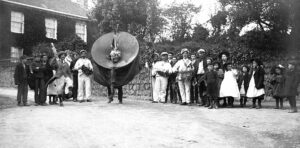 This is one of three separate pictures from the exceptional Yelland Collection held by Kresen Kernow. If taken on the same day, they show the strength of the custom in the early 1900s. The young, the adolescent and the adult groups each with their own ‘oss’. They are well worth close scrutiny. A unique glimpse into the past.
This is one of three separate pictures from the exceptional Yelland Collection held by Kresen Kernow. If taken on the same day, they show the strength of the custom in the early 1900s. The young, the adolescent and the adult groups each with their own ‘oss’. They are well worth close scrutiny. A unique glimpse into the past.
John Buckingham – a Padstow man through and through – brings us this collection of archive material on this ancient Cornish Festival that is so precious to the folk of this town.
Comments and conversations on “The day Padstow people keep up their hobby horse revelry”. So wrote Paul Robins on board the Voluna in 1846, a sure sign the custom had been around for some time.
This is not a history of Padstow May Day but rather a collection of bits and pieces I have come across over the years. Now, in my 88th year, this adds up to rather a lot. It seemed a good idea to try to put some of them together! I am following a long line of interested parties who have followed this path. I do hope others may do the same; it can be a fascinating journey. It is never ending and continues to be rewritten.
My own May Day story began as a small boy aged eight or nine being presented with my very own kid’s oss. Apparently, it was a hand on from Horace Murt whose own boys had grown out of it. Thanks to my mum who undoubtably taught me the words although I have no recollection of that. I would enjoy four years before boarding school took me away from home. In my third year there, I had to give a talk to the rest of the class. My subject, Padstow May Day, of course.
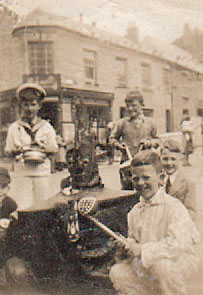 1947 or earlier. Where it all starts for me – in childhood. I’m in the sailor suit.
1947 or earlier. Where it all starts for me – in childhood. I’m in the sailor suit.
What with school and National Service, I was a young adult when I returned, and I became an interested onlooker from then on.
I certainly agree with the following quote by Ronald Hutton (he of the glasses and floppy hair and extravagant shirts often seen in historical TV documentaries) in his 1996 book Stations of the Sun. We of course don’t need to be told this. Nice, however, to know how others see it.
“One of the most famous and most dramatic folk customs of modern Britain”
He wrote in a chapter headed Hobby Horse and Horn Dance:
“These customs do have a way of communicating something genuinely archaic, whatever their actual age.”
Fair comment I suppose; but I, for one, hold with the pagan fertility rite origins that are so frequently quoted.
Here, in 2023, we have had two events in one week with so much in common. The coronation of a King and our May Day have with them a great sense of pride. The ceremony and celebration enjoyed by so many – not least by those taking part.
The sun shone for us and there were smiles all around. You see it in the faces of those you meet, young and old. A hand shake here and there, a hug, everywhere people to meet. We are all here, whether as fortunate residents or casual visitors, to witness a special event. Each of us with our own life experiences sharing in the moment.
The atmosphere was, as usual, electric. Our May Day was alive and well. The maypole in all its glory and the flags in abundance with the branches of sycamore in the doorways. What a setting for such an age-old custom. Both Osses and their enthusiastic followers went past us. The sense of being part of something special was overwhelming. Accordions and drums play the haunting tune that stays with you long after they have passed you by.
“Oss Oss Wee Oss” is the cry and every so often the procession is halted for St George.
“O where is Saint George, O where is he O, He’s out in his long boat all on the salt sea O. Up flies the kite, down falls the lark O, Aunt Ursula Birdhood she had an old Yow, and she died in her old park O.”
We may not be sure what these words mean, but they are sung with such conviction it hardly matters.
In any case, wasn’t Aunt Ursula the one who led the women and an Oss out to Stepper to frighten off the French?
Mention of the coronation of King Charles reminded me of my days guiding at Prideaux Place. In The Grenville Room, named after that most famous of royalist generals of the Civil War, there is a fine portrait of King Charles II and also one of his wife Catherine of Braganza. Have they anything to do with our May Day story?
Also in the same room are portraits of Elizabeth Prideaux and William Morice who became husband and wife at a key time in the history of our country. As the splendid Prideaux memorial in Padstow Church testifies, Sir Wm Morice was ye Secty of State to Charles 2nd so perhaps it was not too difficult to obtain the Royal Pardon for all their past misdeeds, also on display. Here, there is the document to prove it. A small price to pay.
Charles II had been brought out of exile to replace the rule of Oliver Cromwell. This would be called The Restoration. Not only of the monarchy but of those pastimes and pursuits suppressed during commonwealth rule. You’ve guessed it. Maypoles and dancing had been banned. What better time to bring back the May Day revels here?
“Unite and Unite and let us all Unite” so our May song goes. Who is this call for unity aimed at if not at a country so recently at that time riven by Civil War.
I always think our lovely old Padstow Carol Rouse Rouse sends a similar message.
“Rouse Rouse from your slumbers, prepare a glad voice, and join with those numbers that now do rejoice, no longer be silent but now join with them.”
A nation was now free again to express themselves in dance and song.
There is no evidence that this is what happened. However, the Oss and its followers seemed to have enjoyed the patronage of the family at the big house, which in turn would mean the other wealthier families would follow suit. In 1882, in an article in The Graphic, the Parson, Squire and collector of Folk Song, Sabine Baring Gould, noted “the procession went first to Prideaux Place where the late squire always emptied a purse into the hand of the pairs”.
This was, at that time, in the morning. It would seem the groups with the Oss were quite small relative to today’s and were called pairs as in dancers.
Baring Gould also gives details of the Night Singing, the verses being virtually identical to those we hear today. They are sung by men and women from both Oss parties. The leader of the singing is from the Old Oss. These simple unadorned, unaccompanied series of verses announce the start of the celebrations: visiting houses and singing appropriate verses.
“Rise up Miss… All in your gown of green, you are as fine a lady as waits upon the queen. In the merry morning of May.
I warn you young men everyone, for summer is acome unto day, to go in to the green wood and fetch your may home, in the merry morning of May.”
A bit monotonous you may say; but how fitting to begin in this way.
Deane and Shaw, Doc Rowe and our own Donald Rawe, have all written valuable stuff to feed the appetite for information on the subject, and the Echo, in its day, has done its bit by publishing lesser-known items from various sources.
A well-known authority on Folklore matters is Doc Rowe, who himself has an extensive web site with information on all the existing folk customs in the country… and there are a surprisingly large number of them. Browsing through this site, I followed a link to the Bacup Coconut Dancers where I found this statement which I felt I must share with you all.
“Emphasis must be placed on the fact that everything we say is in no way authoritative and is open to debate. However, whatever the history, the Nutters are fiercely proud of their tradition and are much loved and respected by the people of Bacup. One thing is certain; wherever the Nutters go, their appearance, the dances, the music and name of Bacup remains vivid in the memory of people because nowhere is there a traditional dance team quite like the Britannia Coconut Dancers! In a word, they are unique.”
So, there you have it in their own words. I think we would agree with those sentiments; a lot of them also apply to our May Day.
We are not alone in thinking our custom is the greatest. We do indeed stand proud in the ranks of those ancient British customs whether continuous or revived and from whatever origins we care to imagine. Bacup actually claim theirs was brought to the area by relocated 19th century Cornish miners. There’s a thought!
Writing this has brought back memories of the 30-year-old Me and my own interest in folklore and folk song. In the mid-1960s I was involved in pub sing-songs with the much-loved Charlie Bate and sharing one of his moments of fame when he performed in The Manchester Folk Festival in the Free Trade Hall one cold November. Alan Watson, at that time landlord of the Cornish Arms, St Merryn, gave me a lift and we went back stage where the acts gathered. The Spinners and The Ian Campbell Folk Group were there. Fred Jordan, Bob Roberts, A L Loyd, Bob Davenport and Cyril Tawney also. American singer Phil Ochs was on the bill (remember, There but for Fortune, the Joan Baez hit? He wrote that) and, you may have guessed, those Brittania Coconut Dancers. We did not know it at the time but this was what they now call the Folk Revival.
I mention this to illustrate the degree of interest in Padstow May Day that exists and has existed for some time outside of the town and around the world. Check out the Washington May Revels (USA not Co. Durham) on line and you will find a re-enactment of the May song complete with Oss taking place most years, along with accurate representations of other historic customs.
One of the earliest observations on Padstow May Day is from C S Gilbert’s Historical Survey of the County of Cornwall published in 1820. It is significant in that it states: “… the inhabitants dress up a man in a horse’s skin”. This description is not the same as the one detailed in the Bible Christian Magazine just a few decades later which relates fairly closely to the scene we witness today. We are left wondering where Mr Gilbert got his information from. However, there is no mistaking the general feel for the occasion.
“There is an annual jubilee kept up at Padstow, on May 1st, known by the name of the Hobby Horse, in allusion to which, the inhabitants dress up a man in a horse’s skin, and lead him through the different streets. This odd-looking animal amuses, by many whimsical exploits, the crowd which follows at his heels, particularly by taking up dirty water, wherever it is to be found, and throwing it into the mouths of his gaping companions. These tricks naturally produce shouts of laughter, and the merriments are accompanied by songs made for the occasion. The origin of this festival appears to be unknown.”
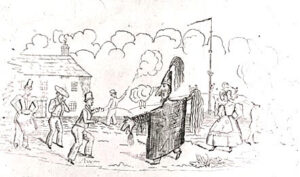 MAC Trebilcock sketch.
MAC Trebilcock sketch.
This early sketch of May Day from the 1830s provides much detail of the way things were. Fife and drums, curious hats and firing of pistols. It was supplied to Thurstan Peter for his talk and publication The Cornish Hobby Horse in 1912, along with written details of the words and music by Mathew Avery Courtenay Trebilcock, a Padstow man who had lived here but moved to Hayle to work as a clerk and lead the Volunteer Artillery Band there. His full name points to a fine Padstow lineage. However, little is known about him. His musical background made him invaluable in any research.
The Rev. Charles Prideaux-Brune was at this time, the Lord of the Manor. He was the first in the Prideaux family to inherit the name Brune. Not yet finished, was the mansion of Thomas Rawlings at Saunders Hill, which did not survive many years. Not long after the book was published, it was being pulled down. Gilbert writes:
“The streets of Padstow are in general narrow and uneven and many of the buildings have an ancient appearance, yet the town has been greatly improved within the last thirty years by the erection of several houses, which are in general very neat. These, together with the numerous gardens which line the sides of the vale, in which the whole is situated, produce when viewed from the water, a very pleasing effect.”
During the grand rebellion, the townsmen appear to have espoused the cause of the parliament, as we are told by Whitelock, in his memoirs of these times, that “In 1645, the inhabitants of Padstow took possession of a vessel in the harbour, and detained two others, which were going to Ireland, to bring over forces in favour of the king: in consequence of which, they were so enraged, that they put all the Irishmen that were found on board, in number about thirty, to the sword. There has lately been erected in the town, a new workhouse, with a schoolroom over it, fifty feet long, by twenty-five broad. The schoolroom was built by subscription, and is for the tuition of children of both sexes, on the plan recommended by Dr Bell – to be supported by subscription. It was opened February 1819; the master’s salary is to be £36 per annum. There is also at Padstow one of the schools founded by the trustees of the Rev. Sir John Elliot’s charitable donations, (1760) each being endowed with £5 per annum. It has other small laudable institutions, for the relief of the industrious poor.”
Today, TV travelogues and travel guides of all kinds alert us to many curious customs throughout the world. Who can fail to see the connection with our Oss and the whirling masked figures from far off cultures? And the splashing noted in the earlier May Day description sounds very much like a custom which takes place on Easter Monday in Slovakia and the Czech Republic. “Men throw water on their chosen women – for some reason the women are supposed to respond peaceably with refreshments and gifts of eggs, hand painted or otherwise decorated. Quite often the women take revenge by dousing the men in cold water the following day.” Fair do’s I say. (info from Lonely Planet Guide).
Dipping, as we are, into the comments made on May Day in years gone by, we quote those of Mr George Rawlings who wrote to Robert Hunt the author of Romances of the West of England on the 1st September 1865.
“Formerly all the respectable people kept the anniversary decorated with the choicest flowers, but some unlucky day a number of rough characters from a distance joined it, and committed some sad assaults on old and young – spoiling all their nice summer clothes, and covering their faces and persons with smut. From that time – fifty years since – the procession is formed of the lowest. The maypole was once decorated with the best flowers – now with only some elm branches and furze in blossom. The horse is formed as follows: the dress is made of sailcloth painted black – a fierce mask – eyes red – horse’s head – horse hair mane and tail distended by a hoop. Some would call it very frightful. Carried by a powerful man – they could inflict much mischief with the snappers. No doubt it is a remnant of the ancient plays, and it represents the Devil, or the power of darkness. They commence singing at sunrise”.
As well as the animal skin comment, the splashing actions are interesting. Quoting from Folklore of Cornwall by Deane and Shaw (Tempus new edition 2003) writing about May dew customs they say:
“The importance of dew may have had some link with the May Day practice of sprinkling with water, dipping, to bring good luck. We have already noted that the Padstow Oss once visited Treator Pool for this purpose and all over Cornwall, dipping was a common custom. In Polperro and Pelynt anyone not wearing a lucky may blossom was dipped, while in Looe, the boys went around carrying bullock horns filled with water. They walked through the town singing. ‘The first of May is Dipping Day. The sixth of May is Looe Fair Day’.”
We should not underestimate the role of the singing of the May Song in that it would have made the use of musical instruments less important. Padstow Museum has some iron triangles used not so long ago – it was a case of using what was available.
This could be a good time to look again at the broadsheet of Padstow May Songs sold in Padstow about 1895 by Harding the stationer. What is shown as the Morning Song is substantially the same that we know today but when it comes to The Day Song, there are major differences. We now only sing part of the second verse together with the last verse at that time where the Oss dies and is resurrected. These same words were published by Williams and Son in 1903 and Thurstan Peter in his book The Hobby Horse 1913.
Somewhere between then and 1950, when the Blue Ribbon Oss Committee produced a leaflet, some verses had disappeared. They acknowledged the 1903 publication and with a write up by Claude Berry, it prints the words as we know them today.
Here are those original verses.
Awake St George, our English knight O,
For summer is come O, and winter is ago,
And every day God give us his grace,
By day and by night O.
Where is St George, where is he O,
He is out in his long boat all on the salt sea O,
And in every land O, the land that ‘ere we go.
And for to fetch the summer home, the summer and the May O,
For summer is acome O and winter is ago.
Where are the French dogs, that make such boast O,
They shall eat the grey goose feather,
And we will eat the roast O,
And in every land O, the land that ‘ere we go.
Thou might’st have shown thy knavish face,
Thou might’st have tarried at home O,
But thou shalt be an old cuckold,
And thou shalt wear the horns.
With Hal-an-tow, and jolly rumble O,
For summer is acome, and winter is ago,
And in every land O, the land that ‘ere we go.
Up flies the Kite and down falls the Lark O,
Aunt Ursula Birdhood she had an old ewe,
And she died in her own Park O.
And for to fetch the summer home &c.
The Chorus is to be repeated alternately.
A further twist to the tale is the presence of some of these verses in Helston where they celebrate the coming of summer in a slightly different way. The Hal-an-tow which precedes the Floral Dance was revived in 1930 and contained elements of the old ceremony. Hal-an-tow and Jolly Rumble O’ is there as in the old Padstow verses.
The French in the Padstow version become Spaniards at Helston. A fact noted by Deane and Shaw in Folklore of Cornwall. More evidence, if it is needed, of the slippery nature of our ancient customs.
As for the sound of the flute. Its shrill note can be heard above the drum beat and the sound of battle. Processional music with a hint of dance? Is this May Day? The 1838 sketch clearly shows a fifer and drummer along with people firing off pistols. Worth pointing out that the hat or mask is different too.
At home, this very much living custom is, I feel, safe in the hands of the Blue and Red Oss Committees who I see as ever protective of this ancient custom, guarding jealously, as well they must, the spirit of the occasion.
Padstow Museum would like to feel it is playing its part in helping, in particular, to preserve the memories with an extensive photographic collection together with artefacts and written material. A DVD of May Day can be seen on a screen provided by Bodmin Folk Club. (Jocelyn Murgatroyd). No strangers to upholding traditions, they are home to Trigg Morris and have strong links to the Bodmin Wassail. Students, broadcasters and the like do call on us for information and we do our best not only to tell the tales but also to advise on the sensitivities that surround our day. Respect is the one word we use most often. I think that applies to all of us. Don’t you?
Nothing quite depicts May Day in times gone by than the 1830s sketch so often used to portray these times.
John Chapman the Padstow born schoolmaster poet had much the same to say:
“At ten o’clock out Hobby comes,
With fifes shrill notes, and beat of drums
Each country lad off from him runs,
And scared out of his wits.
Then guns and pistols blaze away,
And lasses decked with flowers gay,
Do sing the song of sweet May Day
And wish that it would longer stay,
They might prolong their sport.”
In 1837 a CAUTION notice was issued intending to put a stop to the firing of pistols. It was signed by a large number of local people. It seemed to have had the desired effect. Perhaps it was not such an important part of the ceremony. May Day would live on without it.
 The authorities were obviously worried about gatherings of people with guns. A likely source of disorder in those days.
The authorities were obviously worried about gatherings of people with guns. A likely source of disorder in those days.
There was certainly opposition from religious groups notably the Bible Christian Methodists, who saw the whole thing as the work of the Devil, in particular the consumption of alcohol on that day.
“The people have long been in the habit of singularly dressing up some strong man on the first of May, and following him with noisy mirth.”
Nothing new or startling with this statement, as we come round once again to this Day of Days for all Padstow people. Much has been written on the whys and wherefores of this ancient custom of ours and the story of when Thomas Tregaskis, the Bible Christian miller, tried to stop May Day has been quoted many times. His objections were not against revelry as such (otherwise why offer an Ox to be roasted for at least a seven-year period at considerable personal expense) but to that aspect that he saw promoted drunkenness. He had his supporters then and I suspect there are those today who would support his sentiments. He died in 1873, twenty-eight years after the Ox incident and we have from a memoir printed in the Bible Christian Magazine at that time, a description of the day. The writer, I feel, was not totally disapproving of the event that he describes in such detail.
“There is the gown to begin with, made of canvas or some coarse material of the kind, painted black, caused to swell out to its proper dimensions by an enormous hoop at the waist, from which it tapers up to the neck; then the conical headpiece, answering the two-fold purpose of hat and mask, having a mixture of red and black, with a tuft of horse hair at the top. Attached to the hoop behind is a great sweeping tail and in front the snappers with iron teeth, and hair hanging down from it, goat fashion; it is made to snap at the pleasure of the man inside, who holds a string in his hand, slackening which the under jaw drops with its own weight and a twick brings it up with a sharp sound to the upper-jaw. A great part of the fun consists in the man who carries the dress running after people making as if he would snap at them, or lift the gown over their heads.”
“On the evening of April 30th, it might be seen that the town was all astir; for strong young men from the different yards were bringing up the maypole; adorning it with furze erecting it and making it sure with ropes, for the great events of the night. May morning comes, and at a given hour in the forenoon hundreds of young and old are at the windows, watching for a glimpse of the Hobby Horse. The eye of expectation was turned towards the Public House at the bottom of the central street. Here he comes! Crowds outside saluting him with loud cheering and firing of pistols over his head, loaded of course with powder only. There is dancing too and singing of May Songs out into the country first thing, the air rending with frantic noises. Perambulating the town in the afternoon, getting up money, eating and drinking during the day, as they may. Now may be seen the special appendage of smutting – powder made into paste spread on the palm of the hand, then rubbed into anybody’s face, the clearer and fairer the face the greater the fun. Sometimes in place of powder paste, lamp black is used. The day finishes up with dancing, drunkenness, fighting etc. It is as if the Hobby Horse were Bacchus with his many worshippers.”
The writer obviously knew his May Day; I leave it to the reader to seek out the differences with the present day.
“The opinion which prevails among the more intelligent is that it is a relic of druidism, and verily it is worthy to have descended from the days of barbarism.”
On board the Padstow owned emigrant ship Voluna heading for Quebec in 1846 were a group of Bible Christians. I rather feel the crew were aware of their opinions and took full advantage of their captive audience. This is what the leader, Paul Robins, wrote in his diary:
“Friday 1st. The day that Padstow people keep up their hobby-horse revelry. This most disgusting scene was acted by the sailors. An ugly mask was worn by one of them, who went astride a pole, shaped in the end so as to be a very bad imitation of a horse’s head with a tail behind. The man thus masked and covered with tarred canvass down to the feet, galloped about the decks after the sailors and passengers, and then having greased and smutted their hands they rubbed them over the faces of each other and the passengers whom they could catch. Most of us kept below, but Br Hooper being cook, got a black face, and would have fared worse had he not held up the poker in self-defence; and John Heal and Sampson shared the same fate. In the midst of this disgusting exhibition, we passed and spoke the Crown of Orkney Isles, bound also to Quebec. They hoisted a garland in honour of the day, but I was really mortified to think that they should behold such foolish, not to say fiend-like proceedings, in our vessel, and so I told the captain. He said he thought it should be the last time that he would allow it.”
They were not without support in the town which undoubtably gave rise to a Teetotal Oss. The Peace Oss came after that, created in the aftermath of the Great War which brings us up to more modern times.
I will return to John Chapman and his Padstow Hobby Horse poem where he devotes several verses to the foiled invasion of the French by the women of Padstow dressed in red cloaks and led by the Devil-like Hobby Horse.
“Had not a man expressed his sense,
And said a plan he would advance
Would hurry the Frenchmen back to France,
And in a dreadful fright.
He to his townsmen did propose,
And did prepare a Hobby clothes
In order to scare off their foes’
You get the gist he does ramble on a bit.”
He ends with verses about the young ladies who have enjoyed the day.
“Dear Ann, but mother knows I’m out,
And she on me will frown.
Then they break up to home repair,
And to their parents do declare,
That of themselves they’ve taken care –
I trust that that is so.”
Not much has changed there I would say.
Newspaper reports are another source of information, here’s one from 7th May 1896:
“The Hobby Hoss demonstration invariably held on May Day passed off very quietly. The weather was very fair but the followers of the Hoss were less numerous than usual, although if reports be true the collection, which they always devote strict attention, produced a good round sum. There was very little damage to the flower gardens thanks partly to the alertness of Sgt Hugo and those under him. It is, however, evident that the Hobby Hoss demonstration is gradually dying out and will soon cease altogether. To strangers to the town the whole affair seems absurd, and one gentleman at a public meeting expressed his disapproval of it in vigorous terms; but there was not much in the conduct of those responsible for the demonstration that any person could reasonably complain of.”
Eighteen years earlier, this enthusiasm among the local people for May Day caused the headmaster of the Board School to record in his Log Book:
“The influence of Bank Holidays has hardly reached this remote place… On the other hand, May Day in Padstow when almost every other City, Town and Village is in its usual working order is a season of rejoicing amongst the lower classes of a kind beyond ridiculous.”
These words, from over a hundred years ago, send their own message to the present-day custodians of the Obby Oss tradition. I’m sure our sympathetic reporter of the past, along with Boss Harding, the headmaster for the new (1876) school’s first seventeen years, would be truly amazed at the way things are today.
We all look forward each year to see the May Day posters appear in the local shops. A clear reminder that the special day is drawing near. The Old Oss’s distinctive black and red printing catches the eye and we scan the list of names to see the curious nicknames attached to the performers.
When did all this start?
I was recently shown an Old Oss souvenir programme by David Roberts which I will share with you. On the front was a poem. The author is not named but we are fairly sure it was Laurie Giddy.
“This day I wake to greet The Day,
The gentle blossom first in May,
I wind a garland in my hair
And cast away, begone dull care!
For May it is a ‘coming in
And louder shall the echo win;
A measure from this joyful day
A toast then lads to 1st of May.
For outside the Lion the crowds assemble,
From the mighty to the humble,
Adorned with flowers and full of delight,
Anxiously awaiting the clock to strike.
Hark! It strikes and out they come!
The old ‘oss party complete with drum,
Never a spectacle more supreme
Even for our Gracious Queen.
All day round the town they dance
Followed by crowds from far and near.
Always fearing the old ‘oss glance
As he bolts the crowds to clear.
But too soon the shadows creep,
The birds and flowers prepare to sleep,
May Day is drawing to its close,
One last look round and sweet repose.”
Why should we remember Laurie Giddy who died in London on 12th January 1967 aged 55? While working away, he made frequent visits to his family living in Oak Terrace and maintained a keen interest in the football club, wrestling, and particularly the Old Oss Party. I understand that it was he who acquired the top hat and tails for Tommy Gregor who made such a splendid figure in the May Days of my youth.
As the 1952 poster put it:
Sir Thomas Gregor – Wat-Weather, O B of Gatherer, who so distinguished himself at the Royal Albert Hall, London, has again most graciously consented to be Director of Ceremonies.
I think comic names had been used before and checking through the Cornish Guardian reports that we have copies of in our museum, I came across the report published on the 3rd May 1912 – some 40 years earlier.
Programme of the Ossy League 1st May 1912 under the direction of the Marquis of Cove KCS.
4am: Duet The Ossy Morn is dawning by the Hotel and Rock View Cocks specially trained by Professor Samuel Tildes.
6am: Peel on Bells “Ossy Echoes”.
8am: Meet of the Ossy League at the Golden Lion.
10.15am: Preliminary Roll by Signior Brentano.
10.30am: Start, carried by Don Carlo De Bate.
10.45am: Snapper Dance by Lovely Mac.
12 Noon: Treator Day Song by Massed Ossy Choirs.
12.30pm: Oss fed by Countess of Martlebury.
2.30pm: Market Square. Juggling Display “The Magnetic Broom by Professor Coo”
3.0pm: Dance by “Oss Damsels” introducing skirt dances by well known artistes.
3.30pm: Merry Rig Dance by combined Osses, Snapper Duet by Bato and Vanguard.
4pm: Entertainments by Fish Buyers, Salesmen, Packers and Skippers introducing Dolly & Scarlo and their famous “Lowestoft Twist”.
8pm: Cinematograph “Niddle And Nance” on “Adrift on the King’s Highway”
The celebrations were somewhat marred by the inclement weather; but this did not prevent the attendance of a large number of followers of the three Hobby Horses which paraded the principal streets. There were very few trawlers in the harbour so that the amusement usually caused by the fisherfolk on these craft was missed. (Guardian report, thanks to the late Roger Lacy).
In the 1952 list we see the touch of Laurie’s hand in the composition. How many times the list appeared during the preceding 40 years we can only speculate. An idea had been born that would delight and amuse Old Oss followers and the rest of us who look forward to the appearance of the posters in the shops. Today, however much of a tease it might seem, Old Oss members are eager to find their names on the list.
Folklorist Violet Alford wrote of the Oss in her book The Hobby Horse and other masks:
“When I first saw him, he was attended by Signor Brentano, Colonel de Bato, Don Carlos de Bato, Charles Vanguard (Gard?) accordionist, Trevethan Redd who plays funny like and Lively Mac. I never knew who these foreign gentlemen were, but their names live amongst the Padstow people, and indeed they do.”
She would be delighted to know that the tradition of humorous names continues with the list appearing on the Old Oss poster each year.
Lively Mac was John Henry MacEwen, born in 1871, the grandson of a Scottish-born ship’s carpenter. He was noted for his teasing skills and the various costumes he wore. Early May Day pictures show him wearing a wide brimmed lady’s hat, sometimes with a frock and even a harlequin costume. He never seemed to tire of dressing up. I can remember the Old Oss group taking part in a carnival in the 1950s. The theme, The Koreans Retreat from Seoul. Old Mac, as he was then, was the centrepiece, sitting in a cart, wearing a coolie hat and looking suitably oriental. Charlie Bate played, In a Persian Market and the picture was complete.
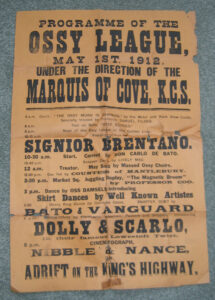 This poster came to light among his mass of history related papers after the tragic death of Barry Kinsmen. The text had been known but the style of the poster presentation tells of the desire to present May Day as a performance – part of a show.
This poster came to light among his mass of history related papers after the tragic death of Barry Kinsmen. The text had been known but the style of the poster presentation tells of the desire to present May Day as a performance – part of a show.
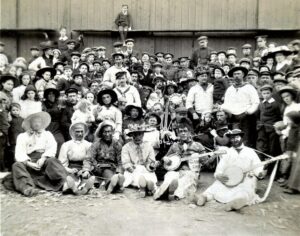 May Day 1910 with Lowestoft Fishermen. One of my favourite pictures, contemporary with the 1912 era poster, showing a diversity of costume more reminiscent of a carnival than May Day. The large number of East Coast fishermen in the town were joining in in their own way. It was the end of their season, and they were letting their hair down. One of them mimicking The White Eyed Kaffir of Music Hall fame. (Museum copy from Moira Gill)
May Day 1910 with Lowestoft Fishermen. One of my favourite pictures, contemporary with the 1912 era poster, showing a diversity of costume more reminiscent of a carnival than May Day. The large number of East Coast fishermen in the town were joining in in their own way. It was the end of their season, and they were letting their hair down. One of them mimicking The White Eyed Kaffir of Music Hall fame. (Museum copy from Moira Gill)

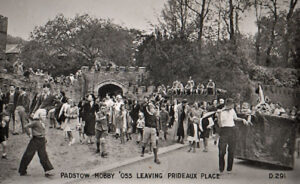 George Ellis captured Padstow May perfectly during the Second World War.
George Ellis captured Padstow May perfectly during the Second World War.
Anyone who has seen the Oss Oss Wee Oss film, made in 1953, will remember the sequence with Old Mac in his wheel chair offering advice to his eight-year-old grandson, Willie, who was seen teasing the Oss in true Lively Mac style. Grandfather Willie is today rightfully proud of his family connections with May Day. Like so many families, the Macowen’s enthusiasm for the day does not diminish as the younger generations take their place in the celebrations.
John Henry died in 1956 aged 85. A memorial cross has been placed on the grave of Old Mac and his wife in Padstow Cemetery. It was previously unmarked.
In 1952, the men in charge were described as 83-year-old Commodore John Henry Macowen O O of Lodenek and Col Walter Bate O O of Lanadwell.
Accompanied by The Doom Bar Pirates:
Fearsome Will Macowen of Polpepper
Terrible Tom Bate – Tavern Hill
Demon Owen Curtis – Trewindle St
Brimstone Charles Bate – Lanwethenoc
Sinister Tom Jasper – Tre-Reen-Fields
Torturer Bill Chainey – Alhus-Vit
Devilish Tom Gard – Market Pentices
Terrific Roderick Rosevear – Percose and Park-O
Fearsome Ernest Bate – Polbrandy and Benaber
Cruel old Jasper, V O – Pipers Pool Passage
Thumb-screwer Shakles Bate – Fentonluna
Graminaceous Jack Macowen – Prawnter Rock
Vampire George Giddy – Meachums Close
Ramrod Thomas Bartle Stone – Punion Hill
Thunderous George Bate – Parken Garrett
Powder Kegg Tommy Giddy – Ladywell
Special mention is made of, the talk of the town, “that midget Willie Macowen, the artful teaser and terror of the Oss”.
We credit Walter Chapman for the Doom Bar Pirate look of the Old Oss Party, but I wouldn’t mind betting that Laurie had a hand in that too.
These reports from the past, help us to understand how much and how little May Day has changed over the years.
Where would Patrick de Bato, Mathew Lodenek Lover Chown or Owen Sailors Return Curtis be without these names from the past? Over 50 names on last year’s Old Oss poster and many of these for family groups, fathers, sons and brothers. This year, raise a glass to that unknown person in 1912, and to Laurie Giddy in the 1950s, who made sure this much-loved aspect of our May Day continued.
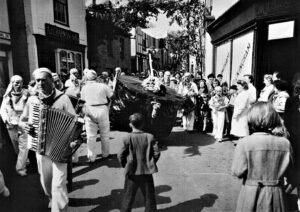 May Day in the 1950s with my family’s grocery business on the right. A part of my life experience – now history.
May Day in the 1950s with my family’s grocery business on the right. A part of my life experience – now history.
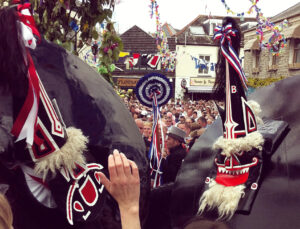 This picture was chosen because it captures for me one of the multitude of special moments that occur on this special day. (Photo: Caroline Carter) Fortunately many captured on film. The two Obby Oss parties rarely meet during the day but in the early evening it has become the practice for them to meet at the maypole and perform together. Truly Unite and Unite. After all this is one tradition. Both groups share the passion of a shared possession.
This picture was chosen because it captures for me one of the multitude of special moments that occur on this special day. (Photo: Caroline Carter) Fortunately many captured on film. The two Obby Oss parties rarely meet during the day but in the early evening it has become the practice for them to meet at the maypole and perform together. Truly Unite and Unite. After all this is one tradition. Both groups share the passion of a shared possession.
So what makes you a Blue or Red supporter? There are tales!! … and family associations play a huge part but other factors come in to play. One of the many strands that make up the fabric of this special day. If you are lucky enough to be here on May Day, then the thrill of the music, the dancing and the atmosphere is what you get to love about it.
Click to hear this CNMA item:
Charlie Bate on Padstow May Day 1972
https://youtu.be/t4rhmZmhiYQ?si=uqQrTeSp0t7YAuFp
I think that what these voices tell us is that the time to worry is when people stop caring about what happens. No chance of that I hear you say. To all you young men of Padstow and the young women too, the future of May Day is in your hands. Forgive the ramblings of an old man. The story of Padstow’s May Day continues to be written as each year passes and the responsibilities pass from one generation to the next.
We’ll call once more unto your house until another year.
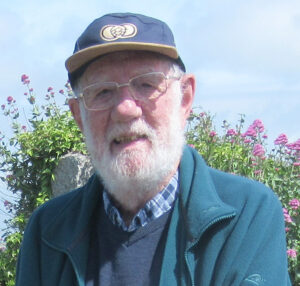 John Buckingham (Bardh Kernow – Spiser Jowan)
John Buckingham (Bardh Kernow – Spiser Jowan)
Living in Padstow and loving the stories I have learned from my life here has given me the encouragement to write about some of them. Thanks to my wife, Liz, for her patience and invaluable help with grammar and punctuation.
Thanks too, to my friends, both past and present, in Padstow Museum and the Old Cornwall Society and to the opportunity given to contribute to the Padstow Echo over a period of many years. Thanks also to Tony Mansell for his help with this article. This is my best shot at it.

Absolutely great
Thanks. Glad someone liked it.
A wonderful read John ! Thank you.
May 3rd,laying in bed resting after another wonder~full Mayday & absolutely loved my morning read John. I hope many more get to read this & relish your hard work, research & personal experience. ThankYOU!
Thank you Mandy. Tony
A true eye-opener
From a respectful observer of such a wonderful tradition..